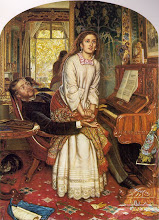
When I was studying for my master’s degree in music in the early 1990s, I took a seminar on the operas of Mozart with a brilliant professor (his other specialty was the Japanese shakuhachi flute, which he played at the level of a master, and for which mastery he’d even received a spiritual name from a Japanese sensei). The class was one of those once-in-a-lifetime learning experiences that make you fall more deeply in love with a subject you love passionately already. I remember particularly well the section on my favorite opera of all, Don Giovanni. Professor B. suggested that when Mozart uses a chromatic descending figure in this opera, it is to illustrate sex – specifically, the destructive force of untamed sexual energy, in an opera in which such a force threatens to loosen society itself from its underpinnings.
That chromatic downward figure occurs throughout the opera; one famous moment is in the duet that Don Giovanni sings with Zerlina, whom he is attempting to seduce on her wedding day, “La ci darem la mano” (the scene is shown above in a photo from Sacramento Opera's production). This duet, wonderful in its simplicity, using such a minimum of resources to show so much about the two characters who sing it, is well-known not only to opera lovers but also to readers of James Joyce’s Ulysses. Don Giovanni tells the peasant girl that he will take her to his castle, where they will give one another their hands, and where she will say “yes” to him (as Molly Bloom says yes at the close of Ulysses). Zerlina is about to go off with him when she is rescued by another of the Don’s conquests, Donna Elvira, who, in the Don Juan legend but not in the opera, is a nun whom he has seduced away from the convent. The descending chromatic line appears in the orchestra at the duet’s coda, when the two are singing, “Andiam, andiam, mio bene, a ristorar le pene d’un innocente amor” (Let us go, beloved, to assuage the pains of an innocent love). Its function is to tell us the truth: that the love Don Giovanni offers Zerlina is far from innocent (he later tries to rape her offstage during a party at his house).
The other night, I turned on the radio and heard the third, adagio movement of Mozart’s great Piano Concerto no. 27 in B-flat Major, K. 595, in a live performance by Imogen Cooper with the London Symphony Orchestra, conducted by Sir Colin Davis on his 80th birthday. It took my breath away – not only the performance, which was full of both brilliance and insight, but also the music itself. I first heard this concerto on an LP that I begged my mother to buy at the supermarket when I was around nine (I don’t know why; I just saw it in a display of classical LPs for $.99 each, and I thought I would like it. It was published by Funk and Wagnall, and featured a nineteenth-century color engraving of Papageno, the birdcatcher from The Magic Flute, on its cover. She acquiesced, and I wore the grooves out listening to it). The elegiac adagio movement is heartbreakingly simple, its theme almost folklike; one can almost see one’s own life pass before one’s eyes when one hears it, in all the bittersweet folly that makes up any life. It also makes frequent use of a downward chromatic figure in the piano theme, later taken up by the orchestra. Hearing it made me think of the long-ago opera seminar. Surely in this autumnal concerto, Mozart was not thinking of sex, but of death; he wrote the concerto just a few months before his own death, when he was living in poverty, and was surely already gravely ill. Perhaps he really used descending chromaticism throughout his work when he wanted to indicate one of those moments of profound, unspeakable truth upon which everything else hinges.











No comments:
Post a Comment